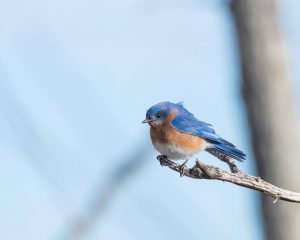For the Birds: From NY Island to the Philippine Islands, Can We Save Our Symbols?
By Brian Kluepfel

This week I attended two local events about symbolic birds – the Eastern bluebird, New York’s state bird, and the Philippine eagle, which is – guess what –the national symbol of the Philippines. The birds seem headed on different paths in terms of conservation.
At last Thursday evening’s Saw Mill River Audubon event at the Mount Pleasant Public Library, our guest speaker was Sandy Morrissey of the Bronx River-Sound Shore Audubon. Morrissey is a licensed bird bander and has been studying bluebirds for the past two decades.
Eastern bluebird populations dropped by about 90 percent in the early 20th century due to the introduction of invasive house sparrows and European starlings, who are cavity nesters, but nastier than the bluebird. Pesticides and habitat loss played a role, too.
But it wasn’t too late to turn things around.
Morrissey spoke about the positive impact of community involvement in building bluebird boxes over the past several decades – thank you, Girl Scouts! – and how box care and maintenance has affected the species in a positive way. (The boxes must be checked regularly to keep out invasive birds like house finches, which are “evil,” Morrissey joked.)
We also found out that our lovely state bird keeps a meticulous pine needle/grass nest (“You could eat out of it!”) and like other thrushes lays blue eggs, but occasionally white. Using wooden fenceposts – not the newfangled plastic ones –helps the birds because they can nest in the decaying stumps. Native plants like sumac are also good to plant.
The sites of live duffers (golf courses) and dead people (cemeteries) are good habitats for our state bird. Morrissey’s data over a short sample period seems to show that non-golfing and golfing birds are surviving and breeding at nearly the same rate.
So, overall, good news for the Eastern bluebird.
Fast forward to last Saturday’s screening at the Ossining Public Library about the Philippine eagle, co-hosted by Teatown Reservation. (It was the only way they could sneak a live turkey vulture into the library.) The film was called “Bird of Prey: Story of the Rarest Eagle on Earth.”
The Philippine eagle was discovered in about 1890. That’s how hard it is to see in the wild. Current estimates of the population range from 200 to 800, although they’re hard to track down with nests in remote, well-hidden treetops. And it only breeds every other year.
A team led by intrepid cinematographer Neil Rettig climbed many arduous rainforest slopes, swallowed a lot of mosquitos and generally risked life and limb to document the Philippine eagle’s breeding in 1978. Then, 36 years later, they did it all again.
A rather comical turn came in 1978 when the visitors convinced then-President Ferdinand Marcos to rebrand the eagle. The name “monkey-eating eagle” was hurting its image among the local populace and even fed the legend that the giant raptor sometimes ate smallish people. Marcos, with the stroke of a pen, changed the name of the now-official national bird to the Philippine eagle.
No ornithologists were consulted on the name change. Then he went shopping with Imelda.
Of more dire consequence, however, was Marcos’ inaction in saving his nation’s rainforest. During his presidency, more than 90 percent of the hardwood forest, upon which the national bird depends for survival, was cut down. No place for the eagle to hunt or nest. Many died in the rampant deforestation.
The Philippine Eagle Foundation is doing all the right things: educating school groups, breeding eagles in captivity, monitoring nest sites for activity and any violation of the eagle’s sacred space. Legally, it’s protected by Philippine law; on the ground and in the skies of the island nation, it’s a different story and many dead eagles are found with bullets in them.
Tracking a hard-to-find species, even in the scattered remaining Philippine rainforest, is a difficult task, as is breeding and releasing chicks with hardly a place to go. The majestic bird is in grave danger.
So for New York’s bluebird, indeed, there is some cause for happiness. For the Philippine eagle, only time will tell. Both are cautionary tales of how quickly we can bring a species to the point of extinction.
Brian Kluepfel is an author for the Lonely Planet guidebook series and just completed work on the most recent guide to Costa Rica. He lives in Ossining and edits the newsletter for the Saw Mill River Audubon. He has also contributed to Birdwatching Magazine. Find him at thewritingkoop.com.

Examiner Media – Keeping you informed with professionally-reported local news, features, and sports coverage.
